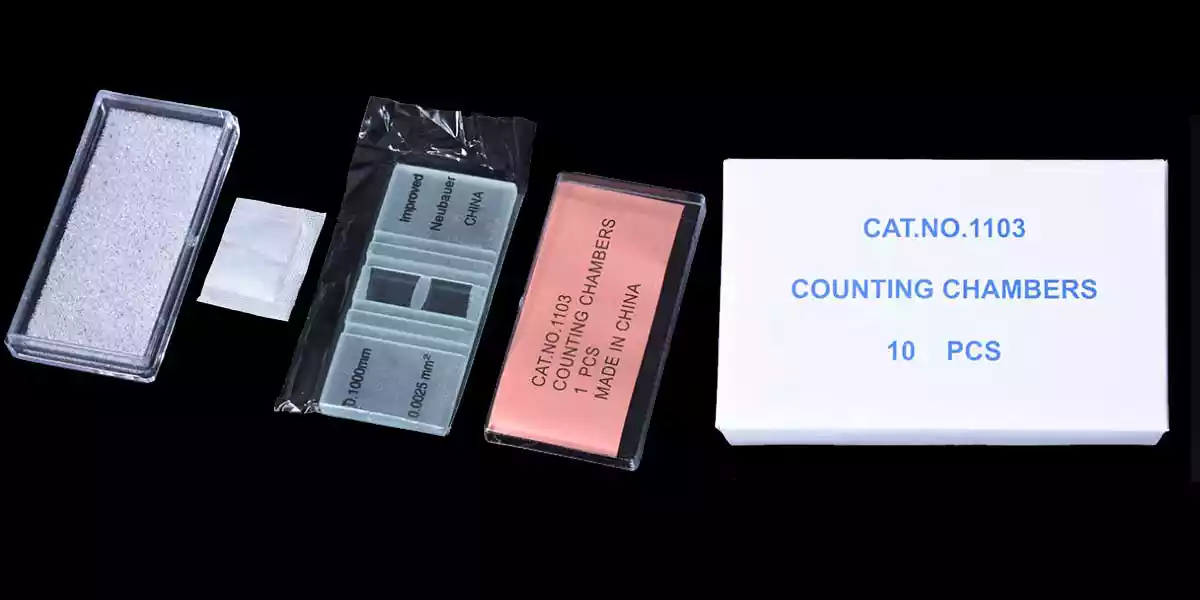The hemocytometer is used for the microscopic counting of red and white blood cells in the human body. It is also commonly used to calculate the number of microorganisms such as bacteria, fungi, and yeast. It is a standard product used in biology.
Material: Frosted glass
Size: 79(L)*39(W)*13(Thickness),Weight: 45G
The hemocytometer is a particular thick glass slide. There are four grooves on the glass slide to form three platforms. The middle platform is vast, and the middle is divided into two halves by a short transverse groove. A small grid is engraved on each half. Each grid is divided into nine large grids, and a large grid in the center is used for counting, called the counting area.
There are two ways of scaling in the counting area. One is to divide the counting area into 16 middle squares (three lines separate the square squares), and each square is divided into 25 small squares. The other is that a counting area is divided into 25 middle squares (double lines separate the central squares), and each square is divided into 16 small squares. However, no matter the structure of the counting area, they all have a standard feature: the counting area is composed of 400 small yards. If the side length of the counting area is 1mm, the scope of the counting area is 1 M2, and the size of each small square is 1 / 400mm. After the cover glass is covered, the height of the counting area is 0.1mm, so the volume of each counting area is 0.1mm, and the volume of each small square is 1 / 4000mm.
Product Feature of the Hemocytometer:
1. Good light transmittance.
2. Corrosion resistance.
3. Stable performance.

Packing: single packing,10pcs/ctn
Imaging effect of the hemocytometer:
How to use the hemocytometer:
Let's take counting yeast as an example:
1. Count the number of yeast in yeast suspension with a hemocytometer.
2. The purpose of sample dilution is to facilitate counting yeast suspension. It is appropriate to contain 4-5 yeast cells in each small square. Generally, it can be diluted ten times.
3. Wipe the hemocytometer with mirror paper and cover the special thick glass in the central counting room.
4. Take a drop of diluted yeast suspension with a straw and place it on the edge of the cover glass to make the bacterial solution penetrate slowly. Absorb the excess bacterial solution with absorbent paper and wait for a moment.
5. When counting, if 16 cells are used × For a 25-cell counting room, take the yeast count of 4 middle cells (i.e., 100 small cells) at the top left, bottom left. Bottom right according to the diagonal position If the specification is 25 grid × For a 16-cell counting plate, in addition to taking its four diagonal directions, it is also necessary to count the number of yeasts in a middle cell (i.e., 80 small squares) in the center.
6. When encountering yeast on the large grid, generally only count the yeast cells on the upper and right lines (or only count the yeast cells on the lower and left lines).
7. Count each sample three times, take the average value, and calculate the number of yeast contained in each 1ml of the bacterial solution according to the following formula
Calculation formula:
(1) 16 grid × Calculation formula of 25-cell hemocytometer:
Number of yeast cells/ml = 100 number of yeast cells in small cells / 100 × four hundred × one hundred and four × Dilution multiple
(2) Calculation formula of 25 grid x 16 grid hemocytometer:
Number of yeast cells/ml = 80 number of yeast cells in small cells / 80 × four hundred × one hundred and four × Dilution multiple
Cleaning of hemocytometer:
(1). Rinse it with tap water.
(2). Refrain from washing it with complex objects.
(3). After washing, dry it yourself or blow it with a hair dryer.
(4). Observe whether there are residual bacteria or other residues in each cell through microscopic inspection. If it is not clean, it must be cleaned again until it is clean, then kept in clean and dry places.